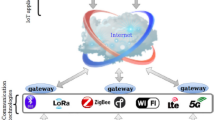Abstract
Internet of Things (IoT) refers to a set of things that are wirelessly connected. The lack of cooperation of nodes, which is due to the reduction of energy level, leads to non-cooperating nodes. Discovering non-cooperating nodes is regarded as one of the main challenges of IoT. In this paper, we addressed this issue by using learning automata where misbehavior of non-cooperating nodes is identified and removed from the network. Simulation results of the proposed method were compared with those of previous works and methods; it was found that the proposed method optimized the other methods in terms of power consumption, throughput, the precision of discovering non-cooperating nodes, and false-positive rate.











Similar content being viewed by others
References
Asadi, M., Jamali, M. A. J., Parsa, S., & Majidnezhad, V. (2020). Detecting botnet by using particle swarm optimization algorithm based on voting system. Future Generation Computer Systems, 107, 95–111.
Atzori, L., Iera, A., & Morabito, G. (2010). The internet of things: A survey. Computer networks, 54(15), 2787–2805.
Chang, J.-M., Tsou, P.-C., Woungang, I., Chao, H.-C., & Lai, C.-F. (2014). Defending against collaborative attacks by malicious nodes in MANETs: A cooperative bait detection approach. IEEE systems journal, 9(1), 65–75.
Chong, Z. K., Tan, S. W., Goi, B. M., & Ng, B. C. K. (2013). Outwitting smart selfish nodes in wireless mesh networks. International Journal of Communication Systems, 26(9), 1163–1175.
Dehestani, F., & Jamali, M. A. J (2020). Load balanced clustering based on imperialist competitive algorithm in wireless sensor networks. Wireless Personal Communications, 1–15.
Ding, Q., Li, X., Jiang, M., & Zhou, X. (2013). A novel reputation management framework for vehicular ad hoc networks. International Journal of Multimedia Technology, 3(2), 62–66.
Hayajneh, T., Almashaqbeh, G., & Ullah, S. (2015). A green approach for selfish misbehavior detection in 802.11-based wireless networks. Mobile Networks and Applications, 20(5), 623–635.
Heidari, A., JabraeilJamali, M. A., JafariNavimipour, N., & Akbarpour, S. (2020). Internet of things offloading: Ongoing issues, opportunities, and future challenges. International Journal of Communication Systems, 33(14), e4474.
Heidari, A., & Navimipour, N. J. (2021). A new SLA-aware method for discovering the cloud services using an improved nature-inspired optimization algorithm. PeerJ Computer Science, 7, e539.
Heidari, A., Navimipour, N. J (2021). Service discovery mechanisms in cloud computing: A comprehensive and systematic literature review. Kybernetes.
Huang, D., Williams, S. A., Shere S. (2012). Cheater detection in vehicular networks. 2012 IEEE 11th international conference on trust, security and privacy in computing and communications. IEEE.
Jamali, J., Bahrami, B., Heidari, A., Allahverdizadeh, P., & Norouzi, F. (2020). Towards the internet of things. Springer.
Jesudoss, A., Raja, S. K., & Sulaiman, A. (2015). Stimulating truth-telling and cooperation among nodes in VANETs through payment and punishment scheme. Ad Hoc Networks, 24, 250–263.
Kerrache, C. A., Lakas, A., Lagraa, N., & Barka, E. (2018). UAV-assisted technique for the detection of malicious and selfish nodes in VANETs. Vehicular Communications, 11, 1–11.
Khan, U., Agrawal, S., & Silakari, S. (2015). Detection of malicious nodes (DMN) in vehicular ad-hoc networks. Procedia computer science, 46, 965–972.
Kumar, J. S., & Zaveri, M. A. (2016). Hierarchical clustering for dynamic and heterogeneous internet of things. Procedia Computer Science, 93, 276–282.
Michiardi, P., & Molva, R. (2002). Core: A collaborative reputation mechanism to enforce node cooperation in mobile ad hoc networks (pp. 107–121). Springer.
Patel, N. J., Jhaveri, R. H. (2015). Detecting packet dropping misbehaving nodes using support vector machine (SVM) in MANET. International Journal of Computer Applications. 122(4).
Qadir, Z., Ullah, F., Munawar, H. S., & Al-Turjman, F. (2021). Addressing disasters in smart cities through UAVs path planning and 5G communications: A systematic review. Computer Communications, 168, 114–135.
Sathyamoorthi, T., Vijayachakaravarthy, D., Divya, R., Nandhini, M. (2014). A simple and effective scheme to find malicious node in wireless sensor network. International Journal of Research In Engineering And Technology, 3(02).
Selvan, M. A., & Selvakumar, S. (2019). Malicious node identification using quantitative intrusion detection techniques in MANET. Cluster computing, 22(3), 7069–7077.
Tootaghaj, D. Z., Farhat, F., Pakravan, M., -R., Aref, M., -R. (2011). Game-theoretic approach to mitigate packet dropping in wireless ad-hoc networks. 2011 IEEE consumer communications and networking conference (CCNC). IEEE.
Touati, M., El-Azouzi, R., Coupechoux, M., Altman, E., & Kelif, J.-M. (2017). A controlled matching game for WLANs. IEEE Journal on Selected Areas in Communications, 35(3), 707–720.
Zannou, A., & Boulaalam, A. (2021). Relevant node discovery and selection approach for the internet of things based on neural networks and ant colony optimization. Pervasive and Mobile Computing, 70, 101311.
Author information
Authors and Affiliations
Corresponding author
Additional information
Publisher's Note
Springer Nature remains neutral with regard to jurisdictional claims in published maps and institutional affiliations.
Rights and permissions
About this article
Cite this article
Niaz, S., Jabraeil Jamali, M.A. Discovering Non-Cooperating Nodes by Means of Learning Automata in the Internet of Things. Wireless Pers Commun 121, 2477–2494 (2021). https://doi.org/10.1007/s11277-021-08832-2
Accepted:
Published:
Issue Date:
DOI: https://doi.org/10.1007/s11277-021-08832-2




